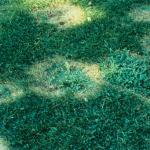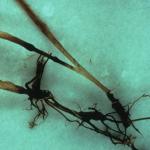Necrotic Ring Spot of Poa Species
The fungus Ophiosphaerella korrae causes necrotic ring spot disease of bluegrasses (Poa species) and creeping red fescue (Festuca rubra). O. korrae is active in the cool, wet periods of spring and fall. Symptoms of disease appear at this time, as infection of the root system impairs the turf's ability to take up water. The first symptoms are small (2-4 in), light green spots which enlarge into patches that can range from 1 to 3 feet in diameter. The turf in infected patches turns reddish brown to bronze and eventually fades to a light straw color. All of the plants in an infected area may die leaving a sunken depression, but more often plants survive and recolonize infection centers resulting in a ring-like or "frog-eye" appearance. Symptoms can sometimes occur as a diffuse yellowing or browning that coalesces into large areas of blighted turf. Neither leaf spots nor aerial mycelium is seen in cases of necrotic ring spot. The disease is characterized by a blackening of roots and rhizomes and dark brown, ectotrophic hyphae on affected roots, rhizomes, and crowns. Roots and crowns may become extensively rotted.
O. korrae survives as mycelium in infected plant debris. The pathogen grows along the surface of host roots and rhizomes and when conditions favor disease development, infection hyphae penetrate to interior portions of the roots. Ascospores (sexual spores) are produced in dark, conical fruiting bodies called pseudothecia. The optimal temperature range for fungal growth is 60-75°F (15-24°C). While the growth of O. korrae is favored by cool, wet conditions, summer heat and drought stress intensify symptom expression. The disease can appear over a wide range of pH, is most severe in compacted soils, and most prevalent on 2-4 year old stands that were established with sod. Left untreated, it typically declines in severity after several years due to the build-up of antagonistic microflora.
Cultural Management
- Raise the height of cut.
- Avoid drought stress. Generally, deep and infrequent irrigation is recommended, but when this disease is severe in hot weather, light daily applications of water will reduce heat stress and stimulate recovery. Syringing during the hottest part of the day cools the turf and enables weakened plants with dysfunctional root systems survive heat stress.
- Maintain adequate levels of potassium and phosphorous fertility as well as optimal nitrogen levels. Slow release or organic forms of nitrogen are recommended.
- Avoid high nitrogen levels, especially during the spring and summer.
- Aerify to reduce compaction, manage thatch build-up, encourage deep rooting, and improve drainage.
- Overseed with perennial ryegrass or reseed with resistant varieties of Kentucky bluegrass or tall fescue.
Chemical Management
Begin preventative fungicide applications in spring when the soil temperature at 3" reaches the range of 60-70°F (15-21°C). Systemic fungicides must be watered in before they dry on the foliage to be effective against necrotic ring spot. Best results are obtained when the turf is irrigated prior to and after application. On lawns, fungicide applications should be made only if all other control measures have been unsuccessful.
For a listing of fungicides currently labeled to manage this disease, refer to the Disease Management chapter of UMass Extension's Professional Guide for IPM in Turf for Massachusetts.


